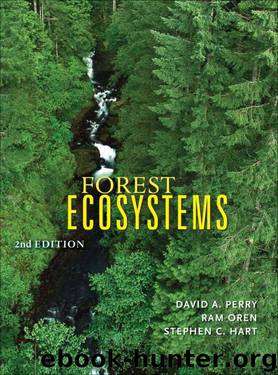Forest Ecosystems by David A. Perry & Ram Oren & Stephen C. Hart

Author:David A. Perry & Ram Oren & Stephen C. Hart [Perry, David A. & Oren, Ram & Hart, Stephen C.]
Language: eng
Format: epub
Tags: Nature, Environmental Conservation & Protection, Science, Life Sciences, Biology, Earth Sciences, General, Ecology
ISBN: 9780801888403
Google: rNfoL3zH6NkC
Amazon: 0801888409
Publisher: JHU Press
Published: 2008-06-19T07:00:00+00:00
1. Nutrients contained in dust and gases that are present on leaf surfaces are soluble and become part of the throughfall. A heterogeneous mixture of gases and aerosols are either raked from horizontally moving air masses (especially clouds and fog) by the canopy or (in the case of larger aerosols) settle onto canopy surfaces under the influence of gravity; collectively referred to as dry deposition, these methods represent a significant pathway by which nutrients and other elements are added to local ecosystems. In forests that are periodically immersed in clouds or fog, elements are additionally deposited on canopy surfaces along with water droplets.
2. Nutrients that are leached from the interior of foliage rather than from leaf surfaces are also added to precipitation as it passes through the canopy. These are not new inputs to the system, however, but part of the system’s internal cycle.
3. Some nutrients are directly taken up by leaves and epiphytes and do not appear as part of throughfall.
Nutrients that are washed from the canopy to the ground may take one of two routes: falling directly to the surface or running along branches and stems to the ground (called stem flow). The former would be captured in a standard collector placed beneath the canopy; however, measuring the latter requires collectors to be placed along stems. Even if all of the routes that water might take from canopies to the ground are measured, we still do not know what proportion of the nutrients in that water represent fresh inputs from the atmosphere rather than leaching from foliage, nor do we know what proportion of total nutrient deposition (both dry and wet) is absorbed directly by canopies and never appears in collectors.
Pollution adds large amounts of nitrogen and sulfur to some ecosystems (Holland et al. 2005; Weathers et al. 2006), a phenomenon that underlies acid rain and that has also generated concerns about nitrogen saturation and consequences for ecosystem health (e.g., Aber et al. 1997; chapters 3 and 20 in this volume).2 Precipitation and other forms of wet deposition accounted for about two-thirds of total inorganic nitrogen deposition across the United States between 2002 and 2004, with highest overall levels in the heavily industrialized and urbanized east. (See http://nadp.sws.uiuc.edu/amaps2/ for animated maps of trends in nitrogen deposition across the United States.) In the mountains of the eastern United States, deposition increases with elevation and, though highly variable, tends to be greater in coniferous than in deciduous forests (Weathers et al. 2006) (fig. 17.2).
Download
This site does not store any files on its server. We only index and link to content provided by other sites. Please contact the content providers to delete copyright contents if any and email us, we'll remove relevant links or contents immediately.
Man-made Catastrophes and Risk Information Concealment by Dmitry Chernov & Didier Sornette(5956)
The Revenge of Geography: What the Map Tells Us About Coming Conflicts and the Battle Against Fate by Kaplan Robert D(4052)
Zero Waste Home by Bea Johnson(3805)
COSMOS by Carl Sagan(3588)
Good by S. Walden(3521)
In a Sunburned Country by Bill Bryson(3507)
The Fate of Rome: Climate, Disease, and the End of an Empire (The Princeton History of the Ancient World) by Kyle Harper(3032)
A Wilder Time by William E. Glassley(2835)
Camino Island by John Grisham(2778)
Organic Mushroom Farming and Mycoremediation by Tradd Cotter(2661)
The Ogre by Doug Scott(2657)
Human Dynamics Research in Smart and Connected Communities by Shih-Lung Shaw & Daniel Sui(2479)
Energy Myths and Realities by Vaclav Smil(2463)
The Traveler's Gift by Andy Andrews(2435)
9781803241661-PYTHON FOR ARCGIS PRO by Unknown(2343)
Inside the Middle East by Avi Melamed(2325)
Birds of New Guinea by Pratt Thane K.; Beehler Bruce M.; Anderton John C(2236)
A History of Warfare by John Keegan(2212)
And the Band Played On by Randy Shilts(2165)
